Plans for a woodland path
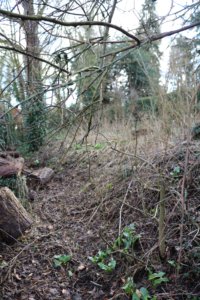
An area that needs taming – wood chip path being planned but planting suggestions gratefully received
My husband always asks me what I’m planning with this part of the garden and I have always responded that it is dedicated to wildlife – the nettles are crucial for caterpillar breeding. In truth there are so many calls on my time and resources that I haven’t had the headspace to deal with it and it’s hardly abounding with wildlife either.
It’s sandwiched between the neighbour’s boundary and a hedge which shields it from the main action of our garden. Out of sight, out of mind.
Yet it has potential. We needed to fell some larch trees here as one had already almost fallen into the neighbour’s garden, and two others were in poor condition. It’s opened up the area to leave light woodland shade and I think it would be nice to clear away the nettles and ivy and open up a wood-chip path through it.
There are already some bluebells and snowdrops but I can imagine more, plus some hellebores. I think I can use the stumps left behind by the tree surgeons to make a little stumpery.
Any other imaginative suggestions from my Six on Saturday friends would be gratefully received.
Far from bland – Anemone blanda
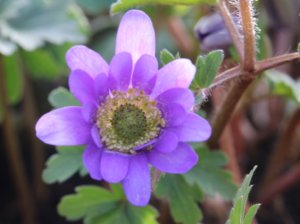
Optimistic face of the Anemone Blanda – happy the snow has melted
This plant was an impulse purchase last week, which immediately succumbed to the weekend snow, squishing all the flowers down. I’d bought them to perk up a lovely little terracotta bowl which was crying out for company.
Of course the pretty blue flowers are now perking up and make lovely specimens to photograph with their hairy stalks and open optimistic faces.
A long overdue pruning job
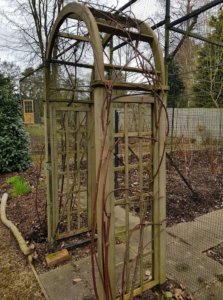
Harsh but fair – rose severely pruned and tied in
My best ever birthday present from my family was a new fruit cage, to replace a rickety old wooden one which the previous owner had made. He was 6 foot 4 and I can’t believe he didn’t clonk his head every time he went into the old cage as it was rather low.
My new cage was tall and spacious and needed a grand entrance. I moved a wooden arch from elsewhere in the garden and put it in front of the fruit cage door. I then planted two thornless roses Rosa ‘Mortimer Sackler’ one each side of the arch.
These have done very well. Six years on and they had covered the arch but had got to the point that all the flowers were at the top. A radical pruning job was long overdue.
Luckily there were lots of long strong new stems from the base so I trained these and others horizontally, and tied them to the arch. I can see signs of new shoots from these, which should grow vertically and carry flowers. I’m optimistic for a floriferous arch this summer.
Apologies for the lack of a before picture – I really should take a pic before I dive in with secateurs – a rookie blogger’s mistake.
The big dahlia pot up
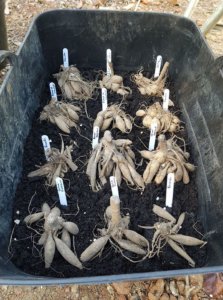
12 tuburs crammed into a large rectangular trug
I don’t know what I was thinking. Despite having at least 30 dahlia plants out in the garden overwintering under a thick layer of mulch, I went ahead in late January and bought myself another twenty or so. They were on a 30% off promotion but I realise that I was overly giddy at the opportunity.
I usually pot them up earlier than this in the greenhouse but even if it had still been standing, I think I may well have waited longer this year because of the cold. This week I went for it and decided they’d have to reside in the dining room. I wasn’t about to carry the compost, pots, labels etc into the house and the shed is still unappealingly cold and dank so I set up a portable wheelbarrow planting-station next to the builders’ cement mixer – in the sunshine.
The builders were intrigued to know what the alien shaped brown things were and I’m not sure they were any wiser when I told them.
To save me from having to carry 20 individual pots into the house I decided I’d plant lots of them up in bulk and I used on old wooden wine crate from the christmas festivities and a very large rectangular plastic trug for the purpose. I put a 15cm layer of compost in each, nestled the tuburs in and then covered them just up to their necks in more compost. Not only did this make the job quicker but I think it also cut down on how much compost I used compared to individual pots. I’ll have to be more careful separating them when it comes to planting out but it should be fine. I’ll move them to my new cold frames in May.
It was the labelling that took the longest time. I almost didn’t bother but I had a word with myself as I know that I’ll be annoyed if a red ‘Bishop of Llandaff’ takes up position in the pulpit of my pale pink and lime colour scheme. Equally skin-toned pink ‘Linda’s Baby’ would be wailing to be noticed amongst the hot coloured loud-mouths of my tropical border.
Inspiration from the past
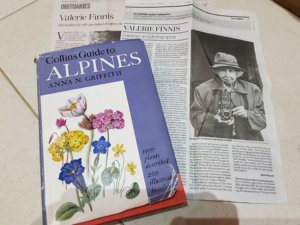
Alpine book containing photographs by Valerie Finnis. Portrait in obituary by Tessa Trager/National Portrait Gallery
I love buying old books and I often find gardening books in second hand book stores and charity shops. When you buy old books it really brings home how cyclical gardening trends are, but whilst botanical knowledge moves on, many of the basics stay the same and these books are great value.
I am interested in learning more about alpines so I bought this second hand book. First published in 1964 it appears it was last published in 1988. Written by Anna Griffith, the photos were taken by Valerie Finnis.
As I opened it, out fell two obituaries of Valerie Finnis that someone had cut out and tucked inside. She died aged 81 in 2006. It turns out she was more than just a garden photographer but was an expert in alpines too. She was a student, then teacher at Waterperry Horticultural School for Women.
Valerie married Sir David Scott in 1970 and moved to his home, at the Dower House at Boughton House. Her horticultural works continued. She was awarded the Victoria Medal of Honour from the RHS in 1970 and had several plants named after her including Artemesia ludoviciana ‘Valerie Finnis’ and Muscari armeniacum ‘Valerie Finnis’.
It was lovely to learn about someone who would otherwise have been just a name on the spine of a book – a happy accident.
However, it was the story of how Valerie and her husband first met that made me smile the most – a tale of shared interests colliding:
I was in my awful old dungarees in the potting shed at Waterperry and a voice outside said, “she’s got Gillenia trifoliata.” I came out and replied “You’re the first person who’s ever known that plant.” That was David. We just sort of fitted in.
Greenhouse update
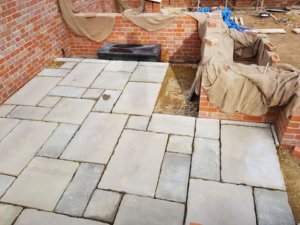
Greenhouse floor and water tank in place
Readers of my Six on Saturday from two weeks ago learned about the building of my dream greenhouse. The base walls of my greenhouse were completed this week and so the manufacturer, Alitex, came round to check the measurements. As the structure is made from aluminium there is no flex and the walls had to have a tolerance of + or – 5mm.
This week’s head scratcher was where to put the utilities. I have installed a water tank which will be under the benching and which will have a hand pump. I am used to using water from rain butts but always used to have to leave my greenhouse and traipse off to my butts to fill up my cans. Having the tank in the greenhouse will be wonderful.
I’ll also have a tap in my new crystal palace. Friends of mine are big advocates of watering systems so there is a chance I could set one up. Having said that I find the time watering plants relaxing and I can check on the progress of my plants.
Plug sockets was the next conundrum. Whenever I’ve done home improvements I’ve worked out how many sockets I need and then doubled it. The same principle applied in my greenhouse and there are sockets for a propagator, a heat mat, an electric heater, the kettle and a radio. Plus another 5 for who knows what!
Six on Saturday is a weekly meme – take a look at the comments at the base of host The Propagator to see more ‘sixes’ from other keen gardeners.

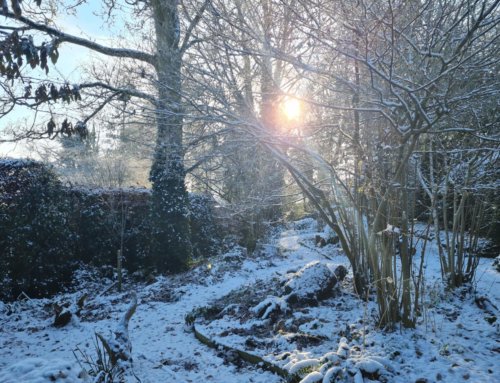
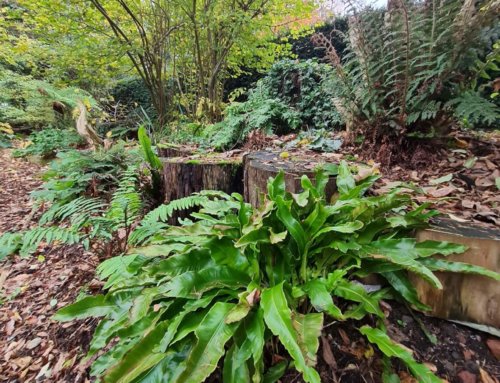
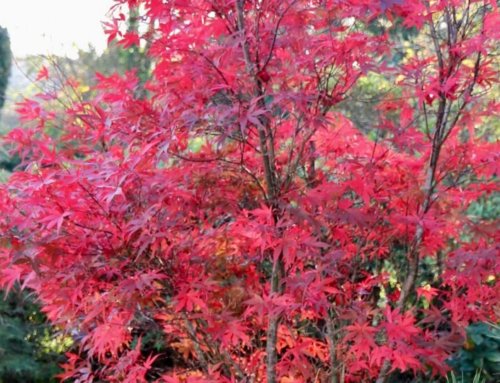
Enjoyed your Six very much and am envious of your greenhouse which seems to be going up very efficiently. Your dahlias look promisingly healthy.
Thanks Homesown. Yes the greenhouse is now coming on after weather-related set backs. I’m impatient for it to be finished as I have a seed back-log and a very full dining room!
Ingenious way of potting up lots of dahlias! Necessity being the mother of invention, and all that. I heard recently about a visiting scheme for people in hospital where a wheelbarrow is planted up and wheeled around for patients to enjoy. I thought this too was quite ingenious.
There’s so much evidence about the healing benefits of plants and gardens. I read a paper by the King’s Fund on that topic. They should have referenced the mobile garden in a wheelbarrow.
Lovely post, with so much going on for you. I just inspected my very shady Broadstairs garden and found that Gallium odoratum was in fine fettle. It is a spreader, but has very fine green foliage and pretty white flower. If you want easy ground cover, it’s an option. I also love Primula vulgaris. Then there’s Euphorbia amagloides . If you are relaxed about spreading plants, then that is always great.
Thanks. I love those suggestions Tim and I’m very happy for spreading plants as there’s plenty of room.
I did like you for my dahlias … all in a big box to force them. Also happy to see the evolution of your greenhouse project!
Thanks Fred. I’m sure it’s much quicker than potting up individually and yes the greenhouse is coming along nicely. I’m hoping for installation in mid April.
I got something from everything of yours this week – the adventure of developing the woodlands, that gorgeous anemone, dahlia problem solving, Valerie’s love story (especially real since I’ve purchased my first ever gillenia trifoliata which I think is going to be scrumptious. Mostly, I’m listening to your greenhouse progress & thinking, now there’s something to work toward in the future. Great Six.
Thanks for the lovely feedback Lora and I’m delighted to hear about your gillenia. I’m tickled pink at the serendipity of your purchase and my book find. I’m always inspired to read about gardening pioneers like Valerie.
What a lovely story about Valerie Finnis! I love old gardening books too and this looks like a treasure – even more so with the newspaper cuttings.
And a great idea for potting up dahlias. Now I’m off to look up Gillenia trifoliata.
Thanks Ciar – yes I had to look it up too but see comment from Lora Hughes – she has one!
Well done sis- keep it coming! Xx your proud elder brother